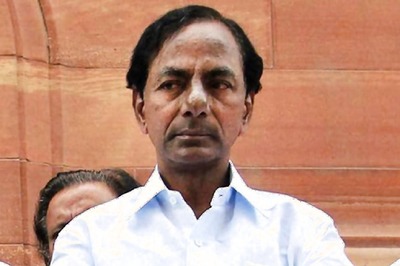
views
New Delhi: India has drastically reduced its infant mortality and maternal mortality rates over the decades, but its still far from achieving the global goals of zero mortality. While maternal mortality is no longer the killer it used to be across the world some time back, it still remains one of the major problems for India, say global leaders in health.
Thirteen years after India helped launch the Partnership for Maternal, Newborn and Child Health (PMNCH) — a multi-nation alliance under the World Health Organisation (WHO) — it again raised curtains off the December 2018 meeting of the forum it will host.
News18 sat down with Dr Michelle Bachelet, former President of the Republic of Chile and incoming board chair of the PMNCH, Helga Fogstad, Executive Director of PMNCH and Dr Flavia Bustreo former Advisor to Dr. Michelle Bachelet before the curtain raiser, to talk about India’s role and future; what Chile can teach the world and how far we have to go to fulfil the sustainable development goals.
The PMNCH was drafted in the Delhi Declaration in April 2005 and according to world leaders, India has since been fundamental in steering the partnership.
The United Nations’ ‘Every Woman, Every Child’ movement calls on countries and PMNCH to end maternal and child mortality by 2030.
Edited Excerpts:
Q: What experiences and lessons have India brought to the table?
Bachelet: Since 1990, India has dramatically reduced its maternal mortality to 174 deaths per 10,000 live births, infant mortality to 34 deaths per 1,000 live births and under-five mortality to 39 deaths per 1,000 live births.
It is the work of successive governments prioritising women, child and adolescent health, of primary care, national schemes and projects with private sector.
Fogstad: The Accredited Social Health Activists (ASHA) project has been expanded here like Ethiopia’s Health Extension Worker project. These health workers not only provide health services to the women, but also help them understand care-seeking behaviour. Women put their health behind that of their husband’s, children and in India, even their extended families. In the Sustainable Development Goals (SDG) era, India can be an example to show the world how to deal with equality. Its project on midwifery can be a game changer for the world. When you make a change in India, you change the statistics of the world.
Bachelet: Efforts here show that countries outside the global north can have and share good practices. Countries with similar backgrounds across Africa and Latin America can have self-cooperation.
Q: The Partnership has seen the world make a transition from the MDG era to the SDG era. Where do we stand now, globally?
Bachelet: It's early to make an evaluation of the results but the main highlight has been the political commitment and leadership to ensure that SDGs can be achieved. It is everyday work to ensure a cross and multi-sectoral approach. It is easy to talk about coordination and cooperation among multiple actors but difficult to make it work. There are many social determinants outside health. It’s important to work for education, sanitation, against child marriage. It was discussed during the MDGs but not grasped fully. If you don’t invest in women and girls you won’t achieve the results. Not every country did all that they can do. If the SDGs don’t focus on this, we run the risk of losing our targets.
Q: Don’t we need to look at women not just as mothers but provide care throughout their lives?
Bachelet: Of course. Previous resolutions of the UN put women along with minorities. We’ve been downsizing women. Education, early childhood development are crucial. The ‘Every Woman, Every Child’ strategy works to ensure education for girls and boys as equals. In Chile, when we recovered democracy, the ministry of education went through all textbooks. Men were shown as doctors and women as nurses with short skirts who looked more like models. We rewrote these books, rewrote books meant for kindergarten students, replacing kings with queens. It’s also important to have female leaders at the panchayat level and at the national level.
Tarja Halonen, who was the president of Finland for 12 years, once spoke to kindergarten children on what they want to be when they grow up. A little boy told her that he could not be the president as in Finland only women are president. He had always seen a woman in that role. How can we show more successful stories of women in roles not always traditional?
Fogstad: We did not focus on maternal mortality because we saw women as baby-making machines. We did so because women were dying. These were unjust, unfair, silent deaths and totally preventable. Now that we’ve made this intervention, we’re focussing on cervical cancer and other issues. The SDGs are not only about reducing preventable deaths, but also better health.
Bustreo: To look at women throughout their life course, we must look at them as girls, mothers and as they grow older. India is lagging behind in some ways. Only last year was the HPV vaccine (for cervical cancer) introduced in the immunisation programme. Globally, maternal mortality has fallen behind cervical cancer, making it the bigger killer of women but in India, it’s still maternal mortality.
Q: What can Chile teach the world?
Bachelet: One of our case studies, which will be showed at the forum, is ‘Chile Grows With You’. It is our early child development intervention through health, education, nutrition, community services and culture. Paraguay and Costa Rica adapted versions of this. Also, our midwives, trained for five years as professional, help with most delivers in the country and have shown excellent results.
Q: How important is the participation and monitoring of the private sector in strengthening systems? What do you think of the private sector involvement in India’s Ayushman Bharat scheme?
Bachelet: The situation changes dramatically from one country to another but any country should try to sync public and private sectors in the best possible way. However, the private sector must set clear standards of quality and of provision of services and professionals. Like how you monitor the public sector, you also need to monitor the private sector.
Fogstad: Prices, and not just out of pocket expenditure, must be controlled. As for Ayushman Bharat, it could be good, as that collaboration between public and private is lacking. It’s too early to say as the plan is in its intentions.
Bustreo: When talking about public and private systems, we need to keep in mind who is financing them. India’s latest scheme looks at more financing from the states. We view this as a good direction. You’re forcing India to progressively increase the proportion of GDP invested in health, which is now only 1.3 percent of the GDP. Whether it is a public provider or private, the financing must be public and regulation and quality in place.
Bachelet: In real life, the private sector will not go where there is a real need, where people have less access to services, as there is no profit. Public care will have to be strengthened. We believe a lot in primary care where many affordable interventions can be done.

















Comments
0 comment